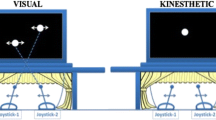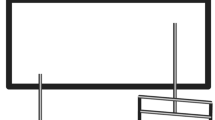Abstract
An experiment was conducted to determine if the performance and learning of a multi-frequency (1:2) coordination pattern between the limbs are enhanced when a model is provided prior to each acquisition trial. Research has indicated very effective performance of a wide variety of bimanual coordination tasks when Lissajous plots with goal templates are provided, but this research has also found that participants become dependent on this information and perform quite poorly when it is withdrawn. The present experiment was designed to test three forms of modeling (Lissajous with template, Lissajous without template, and limb model), but in each situations, the model was presented prior to practice and not available during the performance of the task. This was done to decrease dependency on the model and increase the development of an internal reference of correctness that could be applied on test trials. A control condition was also collected, where a metronome was used to guide the movement. Following less than 7 min of practice, participants in the three modeling conditions performed the first test block very effectively; however, performance of the control condition was quite poor. Note that Test 1 was performed under the same conditions as used during acquisition. Test 2 was conducted with no augmented information provided prior to or during the performance of the task. Only participants in the limb model condition were able to maintain performance on Test 2. The findings suggest that a very simple intuitive display can provide the necessary information to form an effective internal representation of the coordination pattern which can be used guide performance when the augmented display is withdrawn.



Similar content being viewed by others
References
Bangert AS, Reuter-Lorenz PA, Walsh CM, Schachter AB, Seidler RD (2010) Bimanual coordination and aging: neurobehavioral implications. Neuropsychologia 48:1165–1170
Bingham GP, Schmidt RC, Zaal FTJM. (1999) Visual perception of the relative phasing of human limb movements. Percept Psychophy 61:246–258
Boyle J, Panzer S, Shea CH (2012) Increasingly complex bimanual multi-frequency coordination patterns are equally easy to perform with on-line relative velocity feedback. Exp Brain Res 216:515–525
Breslin G, Hodges NJ, Williams AM, Curran W, Kremer J (2005) Modelling relative motion to facilitate intra-limb coordination. Hum Move Sci 24:446–463
Buchanan JJ, Park I (2017) Observation and physical practice: Different practice context lead to similar outcome for the acquisition of kinematic information. Psychol Res 81:83–98
Buchanan JJ, Wang C (2012) Overcoming the guidance effect in motor skill learning: feedback all the time can be beneficial. Exp Brain Res 219:305–320
Buchanan JJ, Wright DL (2011) Generalization of action knowledge following observational learning. Acta Psychol 136:167–178
Buchanan JJ, Ryu YU, Zihlman K, Wright DL (2008) Observational practice of a relative phase pattern but not an amplitude ratio in a multijoint task. Exp Brain Res 191:157–169
Carroll WR, Bandura A (1982) The role of visual monitoring in observable learning of action patterns: making the unobservable observable. J Mot Behav 14:153–167
Deutsch D (1983) The generation of two isochronous sequences in parallel. Percept Psychophys 34:331–337
Fraisse P (1946) Contribution a etude du rythme en tant que forme temporelle. J Psychologie Normale et Pathologique 39:283–304
Hodges NJ, Franks IM (2002) Modeling coaching practice: the role of instruction and demonstration. J Sports Sci 20:793–811
Hodges NJ, Chua R, Franks IM (2003) The role of video in facilitating perception and action of a novel coordination movement. J Mot Behav 35:247–260
Hu X, Newell KM (2011) Visual information gain and task asymmetry interact in bimanual force coordination and control. Exp Brain Res 212:497–504
Jancke L, Peters M, Himmelbach M, Nosselt T, Shah J, Steinmetz H (2000) fMRI study of bimanual coordination. Neuropsychologia 38:164–174
Jin X, Uygur M, Getchell N, Hall SJ, Jaric S (2011) The effects of instruction and hand dominance on grip-to-load force coordination in manipulation tasks. Neurosci Lett 504:330–335
Kelso JAS, Scholz JP, Schöner G (1986) Nonequilibrium phase transitions in coordinated biological motion: critical fluctuations. Phys Lett A 118:279–284
Kelso JAS, Scholz JP, Schöner G (1988) Dynamics governs switching amoung patterns of coordination in biological movement. Phys Lett A 134:8–12
Kennedy DM, Boyle JB, Shea CH (2013) The role of auditory and visual models in the production of bimanual tapping patterns. Exp Brain Res 224:507–518
Kennedy DM, Wang C, Panzer S, Shea CH (2016) Continuous scanning trials: transitioning through the attractor landscape. Neurosci Lett 610:66–72
Kennedy DM, Rhee J, Jimenez J, Shea CH (2017) The influence of asymmetric force requirements on a multi-frequency bimanual coordination task. Hum Mov Sci 51:125–137
Kovacs AJ, Shea CH (2010) Amplitude differences, spatial assimilation, and integrated feedback in bimanual coordination. Exp Brain Res 202:519–525
Kovacs AJ, Shea CH (2011) The learning of 90° continuous relative phase with and without Lissajous feedback: external and internally generated bimanual coordination. Acta Psychol 136:311–320
Kovacs AJ, Buchanan JJ, Shea CH (2009a) Perception-action coordination dynamics: using scanning trials to assess coordination tendencies. Neurosci Lett 455:162–167
Kovacs AJ, Buchanan JJ, Shea CH (2009b) Bimanual 1:1 with 90° continuous phase: difficult or easy? Exp Brain Res 193:129–136
Kovacs AJ, Buchanan JJ, Shea CH (2010a) Perceptual and attentional influences on continuous 2:1 and 3:2 multi-frequency bimanual coordination. J Exp Psychol Hum Percept Perform 36:936–954
Kovacs AJ, Buchanan JJ, Shea CH (2010b) Impossible is nothing: 5:3 and 4:3 multi-frequency bimanual coordination. Exp Brain Res 201:249–259
Maslovat D, Hodges NJ, Krigolson OE, Handy TC (2010) Observational practice benefits are limited to perceptual improvements in the acquisition of a novel coordination skill. Exp Brain Res 204:119–130
McNevin NH, Shea CH, Wulf G (2003) Increasing the distance of an external focus of attention enhances learning. Psychol Res 67:22–29
Mechsner F, Kerzel D, Knoblich G, Prinz W (2001) Perceptual basis of bimanual coordination. Nature 414:69–73
Meesen RLJ, Wenderoth N, Temprado JJ, Summers JJ, Swinnen SP (2006) The coalition of constraints during coordination of ipsilateral and heterolateral limbs. Exp Brain Res 174:367–375
Peper CE, Beek PJ (1998) Distinguishing between the effects of frequency and amplitude on interlimb coupling in tapping a 2:3 polyrhythm. Exp Brain Res 118:78–92
Peper CE, Beek PJ, van Wieringen PCW (1995a) Coupling strength in tapping a 2:3 polyrhythm. Hum Move Sci 14:217–245
Peper CE, Beek PJ, van Wieringen PCW (1995b) Multifrequency coordination in bimanual tapping: asymmetrical coupling and signs of supercriticality. J Exp Psychol Hum Percept Perform 21:1117–1138
Puttemans V, Wenderoth N, Swinnen SP (2005) Changes in brain activation during the acquisition of a multifrequency bimanual coordination task: from the cognitive stage to advanced levels of automaticity. J Neurosci 25:4270–4278
Schmidt RA, Wulf G (1997) Continuous concurrent feedback degrades skill learning: implication for training and simulation. Hum Factors 39:509–525
Semjen A, Ivry RB (2001) The coupled oscillator model of between hand coordination in alternate hand tapping: a reappraisal. J Exp Psychol Hum Percept Perform 27:251–265
Shea CH, Wulf G (1999) Enhancing motor learning through external-focus instructions and feedback. Hum Move Sci 18:553–571
Shea CH, Wulf G, Park JH, Gaunt B (2001) Effects of an auditory model on the learning of relative and absolute timing. J Mot Behav 33:127–138
Shea CH, Buchanan JJ, Kennedy D (2016) Perceptual-action influences on discrete and continuous bimanual coordination. Psychon Bull Rev 23:361–386
Summers JJ, Ford SK, Todd JA (1993a) Practice effects on the coordination of the 2 hands in a bimanual tapping task. Hum Mov Sci 12:111–133
Summers JJ, Todd JA, Kim YH (1993b) The influence of perceptual and motor factors on bimanual coordination in a polyrhythmic tapping task. Psychol Res 55:107–115
Swinnen SP (1996) Information feedback for motor skill learning: a review. In: Zelaznik HN (ed) Advances in motor learning and control. Human Kinetics, Champaign, pp 37–66
Swinnen SP, Wenderoth N (2004) Two hands, one brain: Cognitive neuroscience of bimanual skill. Trends Cogn Sci 8:18–25
Swinnen SP, Dounskaia N, Walter CB, Serrien DJ (1997) Preferred and induced coordination modes during the acquisition of bimanual movements with a 2:1 frequency ratio. J Exp Psycho Hum Percept Perform 23:1087–1110
Wang C, Kennedy DM, Boyle JB, Shea CH (2013) A guide to performing difficult bimanual coordination tasks: just follow the yellow brick road. Exp Brain Res 230:31–40
Wilson GP (2008) Identifying the information for the visual perception of relative phase. Percept Psychophys 70:465–476
Wilson AS, Snapp-Childs W, Coats R, Bingham GP (2010) Learning a coordinated rhythmical movement with task-appropriate coordination feedback. Exp Brain Res 205:513–520
Wulf G (2007) Attention and motor skill learning. Human Kinetics, Champaign
Wulf G (2013) Attentional focus and motor learning: a review of 15 years. Internat Rev Sport Exerc Psychol 6:77–104
Wulf G, Su J (2007) An external focus of attention enhances golf shot accuracy in beginners and experts. Res Quart Exerc Sport 78:384–389
Wulf G, Lauterbach B, Toole T (1999) Learning advantages of an external focus of attention in golf. Res Q Exerc Sport 70:120–126
Wulf G, McNevin N, Shea CH (2001) The automaticity of complex motor skill learning as a function of attentional focus. Q J Exp Psychol 54:1143–1154
Wulf G, Gartner M, McConnel N, Schwarz A (2002a) Enhancing the learning of sports skills through external-focus feedback. J Mot Behav 34:171–182
Wulf G, McConnel N, Gartner M, Schwarz A (2002b) Feedback attentional focus: enhancing the learning of sport skills through external-focus feedback. J Mot Behav 34:171–182
Wulf G, Toellner T, Shea CH (2007) Attentional focus as a function of task difficulty. Res Q Exerc Sport 78:257–264
Zanone PG, Kelso JAS (1992) The evolution of behavioral attractors with learning: nonequilibrium phase transitions. J Exp Psychol Hum Percept Perform 18:403–421
Author information
Authors and Affiliations
Corresponding author
Ethics declarations
Conflict of interest
All authors declare that they have no conflict of interest.
Rights and permissions
About this article
Cite this article
Panzer, S., Kennedy, D., Wang, C. et al. The simplest acquisition protocol is sometimes the best protocol: performing and learning a 1:2 bimanual coordination task. Exp Brain Res 236, 539–550 (2018). https://doi.org/10.1007/s00221-017-5153-7
Received:
Accepted:
Published:
Issue Date:
DOI: https://doi.org/10.1007/s00221-017-5153-7




